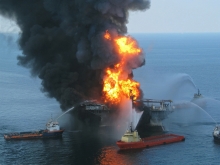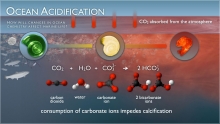Coral reefs have tremendous environmental, economic, and cultural value but are in dramatic global decline. Over the last 4 decades, coral cover on Caribbean reefs has declined by ~80% and on Pacific reefs by more than 50%. Declines are being driven by a host of anthropogenic stresses including global change, overfishing, pollution, and disease spread, but all of these stresses generally result in losses of corals, increases in seaweeds, and then a loss of reef resilience as seaweeds dominate and suppress corals.
Ice sheets have gone through periods of rapid melting, causing sea level to rise many times faster than the current rate of rise. Some of these rapid melting events have occurred during periods when ocean and atmospheric temperatures were at or just above modern temperatures. It is thought that there are instabilities intrinsic in the dynamics of ice sheet flow and melting that may cause such rapid sea level rise events, even without changing climate.
In coastal areas, data are very sparsely available for flow and wave conditions during storm events due, in part, to the logistical challenge of deploying instruments in such conditions. The questions proposed are centered around the strength and consequences of the flow conditions during storm events and the influence of vegetation on mitigating the effects.
Many densely populated coastal areas around the world are low lying and susceptible to relative sea level rise (SLR) associated with climate change, land level subsidence or tectonic subsidence. Coastal defense structures have been constructed as barriers to certain design storm surge, storm wave or tsunami heights. Typically even without SLR the design criteria change over time as hazards get reanalyzed or remodeled. The decrease in risk reduction due to relative SLR and the performance of existing defense barriers under loading conditions beyond the design need to be determined.
Advection and biological consumption are both important sinks for oil and gas released from natural seeps in the Gulf of Mexico. We will use a combination of stable isotope measurements and high resolution modeling with both passive and positively buoyant tracers to study the interaction between physical and biological processes in distributing and transporting the carbon released from natural seeps. We will focus on three major seep fields in the Northern Gulf with different water depths –GC185 (ca. 400 m), GC600 (ca. 1200 m), and GC767 (ca.
Plastic marine debris or the plastisphere impacts marine organisms through ingestion, entanglement, and as a source of toxic chemicals. The plastisphere could also have a major impact on biogeochemical cycles in the oceans. Plastics are transported via major ocean currents to central gyres, where they reside for decadal time scales. The amount of plastic waste is large, exceeding 2 kg/ km2 in central gyres. Even the most recent ocean surveys cannot account for the amount of debris estimated to enter the ocean, with inputs and outputs differing by orders of magnitude.
The characterization of sediment biogeochemistry at high spatial and temporal resolution is a necessary step in predicting the overall pathways and extent of hydrocarbon degradation in areas affected during and after an oil spill. However, geochemical data for sediments from deeper environments are scarce, and most studies do not measure the full suite of terminal electron acceptors involved in sediment diagenesis.
Native microbial communities (microbiomes) of the vertebrate gut exert vital effects on host ecology, physiology, and evolution. This project explores the potential that the gut microbiome of herbivorous fish plays a vital role in biochemically degrading algal toxins consumed by the host fish, and therefore structuring diet choice and ecology. The student will work jointly between the labs of Drs. Mark Hay and Frank Stewart to test this broad hypothesis, likely focusing on the microbiomes of specific coral reef herbivores.
CO2 emission will continue exaggerating, as fossil fuels will most likely remain the major source of energy in next couple decades. The increased carbon in the atmosphere moves into marine ecosystems, making the world’s oceans more acidic. The rate of ocean acidification (OA) today is faster than any time in the past 300 million years.











